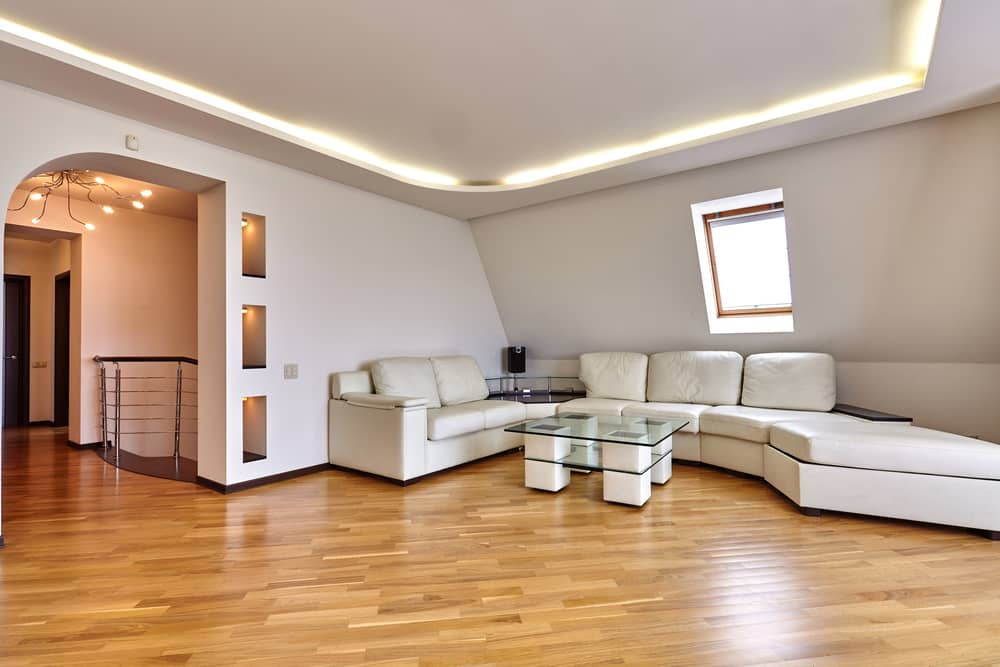If you have a laminate floor, you most likely have floating floorboards installed in your home.
Floating floorboards have become a popular flooring choice for many homeowners due to their versatility, aesthetic appeal, and relatively easy maintenance.
If you prefer the DIY approach, here’s a guide to help you keep your floating floorboards in top condition.
What are floating floorboards?
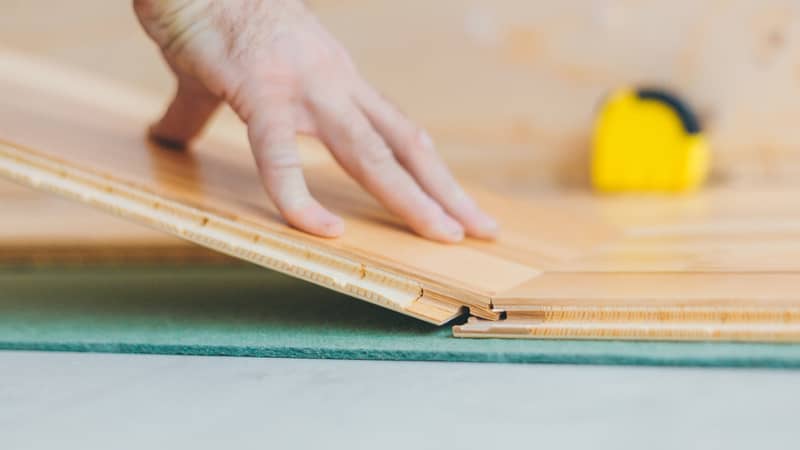
Unlike traditional floorboards, floating floorboards are not nailed or glued down.
Instead, they “float” on top of a substrate or underlayment, or even your old flooring!
They are often interlocked using a tongue-and-groove system, making the installation process simpler and quicker.
Many homeowners choose floating floorboards for the ease of installation and the ability to place them over various types of subfloors, including concrete and older wood floors.
Wait, are floating floors and floating floorboards the same?
Yes, the terms “floating floors” and “floating floorboards” often refer to the same type of flooring installation.
Both terms describe a method where the flooring material is not directly fastened (nailed or glued) to the subfloor beneath it.
What are the different kinds of floating floorboards?
The floating installation method is common with various types of flooring materials, including laminate, engineered hardwood, and luxury vinyl planks.
Floating laminate flooring
This is made from a composite wood material pressed together at high temperatures.
The photographic image of wood (or another type of material, like stone) is then placed on top to give the appearance of real wood or stone.
Engineered hardwood floors (floating timber floors)
This is made from multiple layers of wood veneer compressed together.
The top layer is genuine hardwood, giving the appearance and feel of solid, natural wood, while the underlying layers provide added stability.
Luxury vinyl planks (LVP)
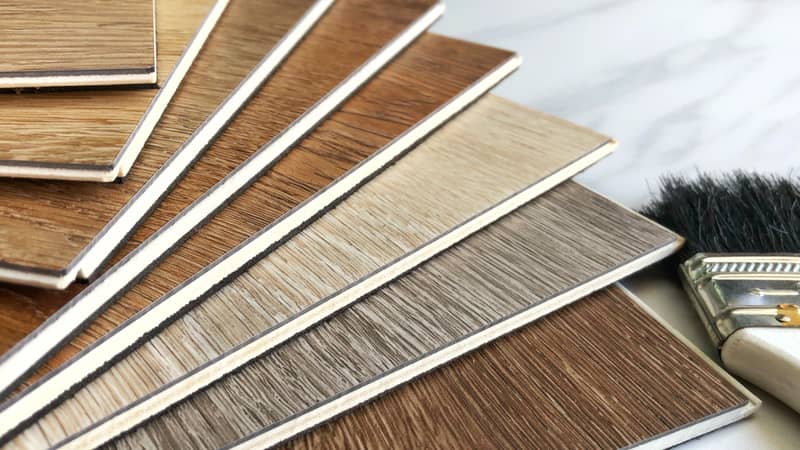
This is made of flexible PVC.
LVP can imitate the look of real wood, stone, or ceramic tile and often includes a textured surface.
What do I need to clean floating floors?
- A soft bristle broom, dust mop or microfibre mop: This is essential for daily or regular cleaning to remove dirt, dust, and debris without scratching the floor’s surface.
- A vacuum cleaner (with a hard floor setting): Can also be used for regular cleaning. Make sure it doesn’t have a beater bar or brush that rotates, as this can damage the floor.
- A spray bottle with a gentle floor cleaner: Depending on the type of floating floorboard you have, a gentle floor cleaner specifically designed for that material should be used. Avoid harsh chemicals or those that leave a residue.
- Soft microfibre cloth or mop: To wipe or mop the floor after applying cleaner. Always wring out excess water to avoid over-wetting the floor.
- Bucket: If using a mop, a bucket will be necessary to mix the cleaning solution and water, if required.
- Dry towel or cloth: To quickly wipe up any excess water or spills. It’s crucial to keep moisture to a minimum on floating floors, especially laminate and wood, to prevent damage.
- Floor protector pads: While not for cleaning, placing these under furniture can prevent scratches and extend the life of your floorboards.
Best way to clean floating timber floors
As with regular wooden floorboards and other timber flooring, floating timber floors can warp when they get soaked too long or when subjected to extreme heat.
Here’s what our cleaning experts have to say about how to clean floating timber floors properly.
Step 1: Begin with regular sweeping or vacuuming
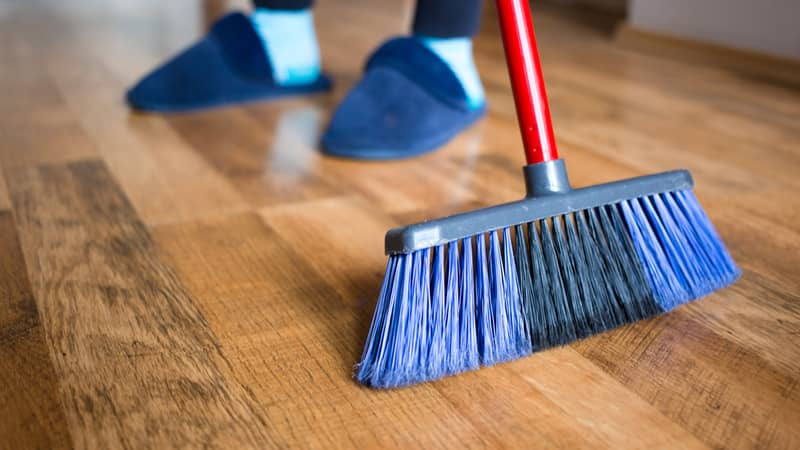
Sweeping or vacuuming removes dirt and dust from your floating floor.
This will remove dirt, dust, and debris that can scratch the surface.
Unless your floor is particularly muddy or sticky, a regular sweep should be enough to keep it clean. You can use a broom or dust mop for this step.
Step 2: Wipe off spills and stains
Using a soft cloth, wipe away spills immediately to prevent the liquid from destroying the wood.
Spot clean sticky spills with a damp cloth, then wipe with a piece of dry cloth.
Step 3: Use a soft, damp cloth or mop
Mopping your timber floor is only necessary when the dirt cannot be removed through sweeping and spot cleaning.
Soak a microfibre mop in warm water, then wring thoroughly. Take care to remove excess water that can seep into your wood floor.
Mop in the direction of the wood grain.
If your flooring has hard-to-remove stains, use a spray bottle to apply a small amount of cleaning solution. Avoid using excessive water, as it can damage the floorboards.
Step 4: Opt for a mild cleaning solution
If your floorboards require more than just water, go for a cleaning solution specifically formulated for timber or hardwood.
Always check the manufacturer’s instructions and spot test in a conspicuous area before using it on the rest of your floating timber floors.
Step 5: Buff and let the floating floor air dry
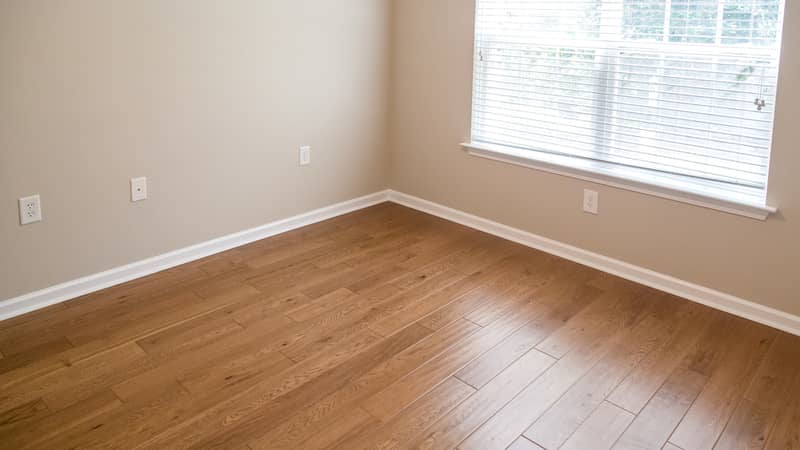
After cleaning, make sure to thoroughly dry the floor to avoid moisture damage.
You can use a dry microfibre mop or sponge mop to soak up the remaining moisture.
This step ensures that your flooring won’t buckle or have any streaks.
Open the windows and doors in the area (if there are any) to let your flooring air dry quicker.
Best way to clean laminate floating floorboards
Laminate floating floorboards require special care because they are more susceptible to water damage.
When it comes to these boards, a frequent gentle clean is more effective than an occasional deep clean and scrub.
Step 1: Sweep or vacuum any dirt
This is the easiest way to clean laminate floors. For spills, wiping is your best option.
When sweeping or vacuuming, make sure to remove all the dirt and tiny particles on the floor as these can cause scratches on your floor’s surface.
Step 2: Wipe spills immediately
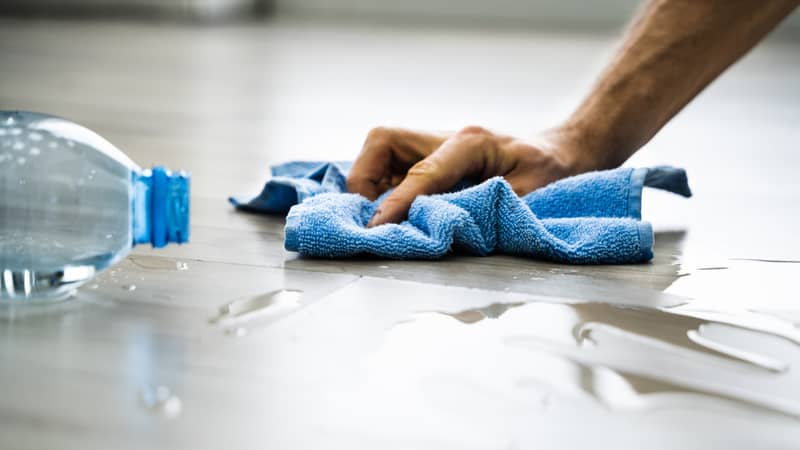
While laminate floors are durable and scratch resistant, liquids can still seep into the planks and cause them to warp.
A quick solution when sauce, juice, wine, and other liquids spill onto your flooring is to wipe with a piece of dry cloth or paper towel.
If the liquid leaves a sticky residue, wipe with a moist towel dipped in hot water, then dry immediately.
Make sure to get into crevices and dry the affected area thoroughly to prevent your flooring from warping.
Step 3: Mop with plain, hot water
Give your laminate flooring a monthly wash with hot water to remove grease and grime.
Dip a mop in hot water then wring out as much liquid as possible.
Clean your floor with the damp (not wet) mop then dry thoroughly with a clean cloth.
Hot water is a good floor cleaner for your laminate floor because it can melt residue without destroying the quality of your planks.
This will help maintain the overall appearance and cleanliness of your floor when combined with a weekly sweep.
Step 4: Wipe with a dry mop then allow to air dry
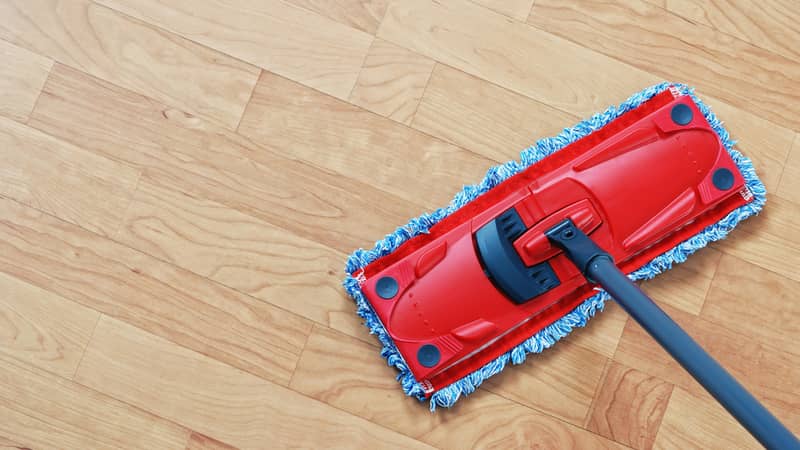
Dry your laminate flooring using a clean microfibre mop, then allow it to air dry.
Best way to clean LVP floating floors
Luxury vinyl plank (LVP) flooring combines the beauty of hardwood with the resilience of vinyl, making it a popular choice for commercial properties.
However, they can still be used in homes! If you have them, here’s how you can clean and maintain them:
Step 1: Sweep or vacuum dust and debris
Get a broom or dust mop to sweep away any debris, or use a vacuum with a hard floor setting.
This removes the daily accumulation of dust, dirt and grit which can scratch the surface of your LVP floating floorboards over time.
Step 2: Prepare a mild cleaning solution
Fill a bucket with warm water and add a few drops of gentle, pH-neutral floor cleaner.
Avoid using acidic solutions like white vinegar or excessive soap as they can damage the LVP floor finish or leave residue!
Step 3: Use a damp microfibre mop on your LVP flooring
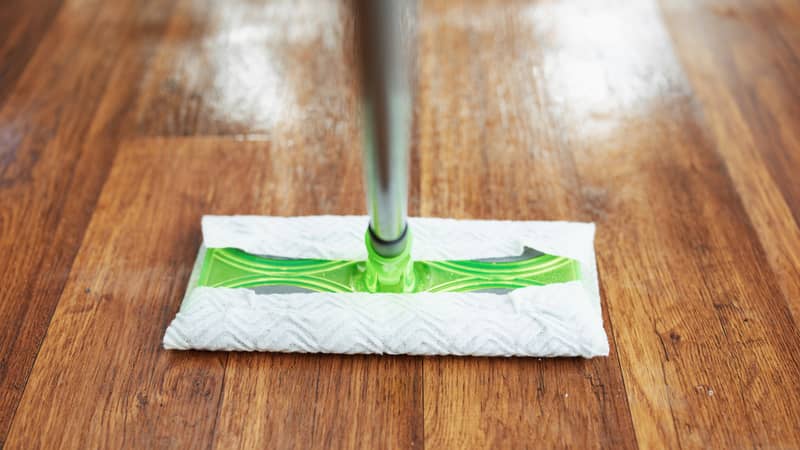
Dip your microfibre mop into the cleaning solution and wring it out until it’s damp.
Mop your floors, following the lines of the planks.
Step 4: Rinse the floorboards if needed
If you notice some residue on your LVP floors, mop over them again using clean, warm water.
Step 5: Dry your LVP floorboards
Dry the floor with a clean microfibre cloth (or another microfibre mop head) to prevent water spots from forming on the surface.
Pro tip: Act quickly if you have spills
Always clean spills immediately to keep your floors pristine and stain-free.
FAQs about how to clean floating floorboards
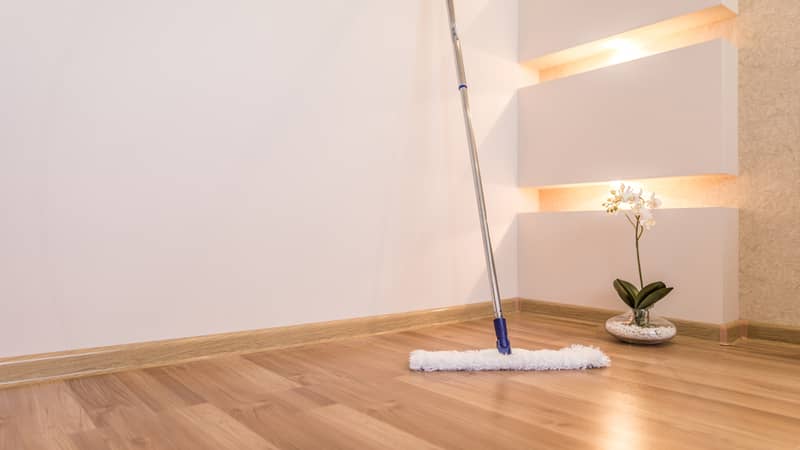
What should I remember when cleaning floating floorboards?
These are the top things to remember when cleaning your floating floorboards:
- Sweep at least once a week to maintain your flooring.
- Wipe spills as soon as they happen to prevent liquids from seeping into the wood.
- Use a damp but not wet mop when cleaning.
- Use a cleaning solution made specifically for the material of your floating floorboards.
What shouldn’t I do when cleaning floating floorboards?
Here’s a list of things you shouldn’t do when cleaning your floating floorboards:
- Don’t use harsh chemicals that can destroy the surface of your floor.
- Don’t let water soak into your floorboards.
- Never use a steam mop on your laminate floorboards. The high heat can destroy the wood and cause it to warp.
- Don’t leave wet fabrics like wet rags or carpets on your floating floor boards.
- Don’t use a vinegar and baking soda solution. Baking soda may have an abrasive effect on your boards’ surface, while vinegar can seep into the wood and cause permanent bleaching and damage.
- Don’t use abrasive cleaning tools like metal brushes on your floorboards.
- Don’t use wax on your floating floorboards.
How do I make my floating floors shiny?
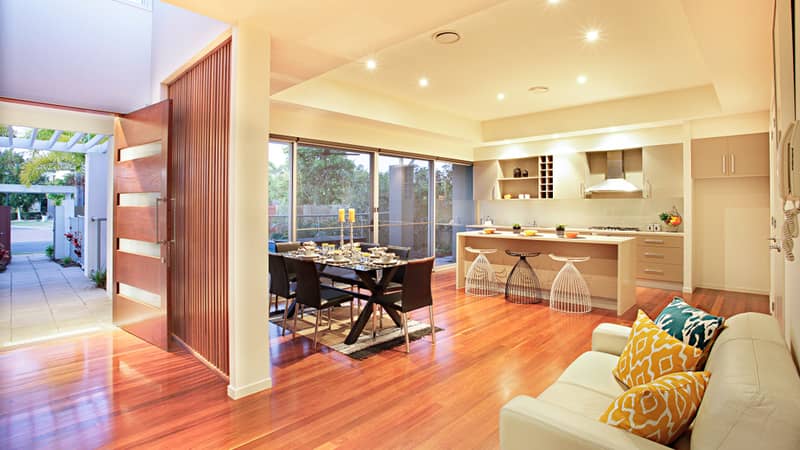
To make your floating floors shiny, follow the cleaning steps mentioned above, then dry your flooring with a microfibre cloth.
This extra step will prevent streaks from forming and ensure that your floorboards are buffed and polished well.
You can prevent lacklustre floorboards by cleaning regularly, drying thoroughly, and avoiding harsh chemicals.
Can you use a steam mop on floating floorboards?
Never use a steam mop on floating floorboards.
While your boards may be durable and able to withstand enormous weight, the extreme heat from a steam mop can still cause serious damage to your floor.
Can you clean floating floors with vinegar?
No! White vinegar can damage the surface of your floorboards because of its acidic nature.
It’s best to clean your floors with plain, hot water.
How do I remove chewing gum from floating floors?
To remove chewing gum from floating floors, first harden the gum by placing ice or a cold pack over it for a few minutes.
Once it’s brittle, gently scrape it off using a plastic scraper, ensuring you work in the direction of the floor grain to prevent scratches.
If any gum residue remains, dampen a cloth with a small amount of eucalyptus oil, rubbing alcohol, or a floor-safe adhesive remover (always test in a hidden spot first), and gently rub the spot.
Finish by wiping the area with a clean damp cloth and then drying thoroughly.
Let your worries float away
Keeping your floating floors clean is essential not only for aesthetics but also for longevity.
Whether you’re dealing with timber, laminate or luxury vinyl floating floors, each type requires specific care to maintain its beauty.
Remember to always be gentle, avoid excessive moisture, and consult the manufacturer’s guidelines.
With the right care, your floors can remain a shining focal point in your home for years to come.
Consider hiring a cleaning professional for periodic deep cleaning to ensure the best care for your investment.

